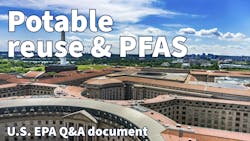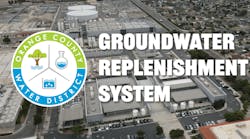Key takeaways from U.S. EPA's Potable Reuse and PFAS Q&A document
The U.S. Environmental Protection Agency (EPA) Water Reuse Program published a potable water reuse and per- and polyfluoroalkyl substances (PFAS) Q&A document in December 2024.
The document covers frequently asked questions about potable water reuse and PFAS.
Key questions and takeaways from the document
How does the EPA regulate PFAS in drinking water?
According to the document, PFAS are a large class of chemicals that have been used in industry and consumer products since the 1940s.
People can be exposed to the chemicals through consumer products, occupational contact and/or by consuming food or water that contains PFAS.
The U.S. EPA announced in April 2024 the final National Primary Drinking Water Regulation for six PFAS chemicals. The regulation will apply to public drinking water systems when fully implemented.
What is potable reuse? Is it held to the same PFAS regulations as other drinking water?
The EPA document states that potable water is water that is used for drinking water and other household uses. Potable reuse is the use of recycled municipal wastewaters for such purposes.
The EPA states that all drinking water supplied by a public water system must meet federal standards, regardless of the source.
How do PFAS get into the potable reuse water supply?
Potable reuse is highly treated wastewater. According to the EPA, influent can contain PFAS from sources including industrial dischargers and household products in wastewater.
What treatment technologies are available for facilities to reduce PFAS levels?
The EPA document lists four technologies that can be used to reduce the levels of PFAS in potable reuse systems.
The technologies include the following:
- Granular activated carbon (GAC)
- Anion exchange resins (AIX)
- Nanofiltration (NF)
- Reverse osmosis (RO)
Examples of potable reuse systems using these treatment technologies
The U.S. EPA states that the Orange County Groundwater Replenishment System in California uses RO technology. The treatment system can produce 130 MGD and has been operational since 2008.
The Prairie Waters potable reuse project in Aurora, Colorado, uses GAC to remove contaminants. The treatment system can produce up to 10 MGD and has been operational since 2010.
What can potable reuse systems do to prevent PFAS?
The EPA document states that potable reuse facilities can closely monitor different chemicals that enter the system.
The systems can leverage the Clean Water Act or upgrade their treatment systems to prevent PFAS from entering the system.
Similar articles
About the Author
Alex Cossin
Associate Editor
Alex Cossin is the associate editor for Waterworld Magazine, Wastewater Digest and Stormwater Solutions, which compose the Endeavor Business Media Water Group. Cossin graduated from Kent State University in 2018 with a Bachelor of Science in Journalism. Cossin can be reached at [email protected].


